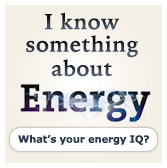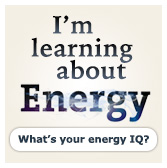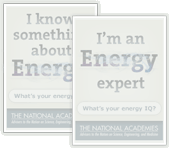
What You Need To Know About Energy
What do you know about energy?
What percentage of commercial building energy is used by schools?
-
Sorry, that’s incorrect.
School buildings represent 13% of commercial buildings energy use, or about 2.5% of total U.S. energy use (13% × 19%).
-
Sorry, that’s incorrect.
School buildings represent 13% of commercial buildings energy use, or about 2.5% of total U.S. energy use (13% × 19%).
-
Correct!
School buildings represent 13% of commercial buildings energy use, or about 2.5% of total U.S. energy use (13% × 19%).
-
Sorry, that’s incorrect.
School buildings represent 13% of commercial buildings energy use, or about 2.5% of total U.S. energy use (13% × 19%).
Which of the following is considered an obstacle to cars running on hydrogen fuel cells?
- Cost of fuel cells
- Difficulty storing and transporting hydrogen
- Process of collecting pure hydrogen
- All of the above
-
Sorry, that’s incorrect.
All of the reasons mentioned are considered obstacles to producing cars that run on hydrogen fuel cells.
-
Sorry, that’s incorrect.
All of the reasons mentioned are considered obstacles to producing cars that run on hydrogen fuel cells.
-
Sorry, that’s incorrect.
All of the reasons mentioned are considered obstacles to producing cars that run on hydrogen fuel cells.
-
Correct!
All of the reasons mentioned are considered obstacles to producing cars that run on hydrogen fuel cells.
What technology was most responsible for increase in lighting efficiency from 45 Im/W in 2001 to 58 Im/W in 2010?
- Increase in efficiency of incandescent light bulbs
- Increase in efficiency of candles
- Increase use of compact fluorescent lights
- Increased use of LED lights
-
Sorry, that’s incorrect.
Increasing market share of compact fluorescents was primarily responsible for the increased lighting efficiency between 2001 and 2010.
-
Sorry, that’s incorrect.
Increasing market share of compact fluorescents was primarily responsible for the increased lighting efficiency between 2001 and 2010.
-
Correct!
Increasing market share of compact fluorescents was primarily responsible for the increased lighting efficiency between 2001 and 2010.
-
Sorry, that’s incorrect.
Increasing market share of compact fluorescents was primarily responsible for the increased lighting efficiency between 2001 and 2010.
Which of the following is emitted by coal-fired power plants?
-
Sorry, that’s incorrect.
All of the above are emitted from coal-fired power plants and can be harmful to our health and the environment.
-
Sorry, that’s incorrect.
All of the above are emitted from coal-fired power plants and can be harmful to our health and the environment.
-
Sorry, that’s incorrect.
All of the above are emitted from coal-fired power plants and can be harmful to our health and the environment.
-
Sorry, that’s incorrect.
All of the above are emitted from coal-fired power plants and can be harmful to our health and the environment.
-
Correct!
All of the above are emitted from coal-fired power plants and can be harmful to our health and the environment.
Between 1980 and 2012, after fuel economy standards where put in place, which of the following has happened to vehicles?
- Vehicle weight increased
- Vehicle horsepower increased
- Vehicle fuel economy increased
- All of the above
-
Sorry, that’s incorrect.
Improved vehicle efficiency has allowed for increases in weight, horsepower and fuel economy.
-
Sorry, that’s incorrect.
Improved vehicle efficiency has allowed for increases in weight, horsepower and fuel economy.
-
Sorry, that’s incorrect.
Improved vehicle efficiency has allowed for increases in weight, horsepower and fuel economy.
-
Correct!
Improved vehicle efficiency has allowed for increases in weight, horsepower and fuel economy.
On average, which is most efficient in coverting heat into electic power?
- Coal boiler power plant
- Natural gas-fired turbine power plant
- Natural gas combined-cycle power plant
-
Sorry, that’s incorrect.
On average, a typical coal-burning power plant in 2013 was about 33% efficient in converting heat energy into electrical power. A gas-fired plant was about 42% efficient. And in natural gas combined-cycle power plants—in which waste heat from a natural gas turbine is used to power a steam turbine—generation may be as much as 60% efficient.
-
Sorry, that’s incorrect.
On average, a typical coal-burning power plant in 2013 was about 33% efficient in converting heat energy into electrical power. A gas-fired plant was about 42% efficient. And in natural gas combined-cycle power plants—in which waste heat from a natural gas turbine is used to power a steam turbine—generation may be as much as 60% efficient.
-
Correct!
On average, a typical coal-burning power plant in 2013 was about 33% efficient in converting heat energy into electrical power. A gas-fired plant was about 42% efficient. And in natural gas combined-cycle power plants—in which waste heat from a natural gas turbine is used to power a steam turbine—generation may be as much as 60% efficient.
What type of transportation uses the most total energy?
-
Correct!
By far the largest share of energy in transportation is consumed by cars, light trucks, and motorcycles—about 58% in 2012, followed by other trucks (21%), aircraft (9%), boats and ships (3%), and trains and buses (3%). Pipelines account for 3% and military uses for 2%.
-
Sorry, that’s incorrect.
By far the largest share of energy in transportation is consumed by cars, light trucks, and motorcycles—about 58% in 2012, followed by other trucks (21%), aircraft (9%), boats and ships (3%), and trains and buses (3%). Pipelines account for 3% and military uses for 2%.
-
Sorry, that’s incorrect.
By far the largest share of energy in transportation is consumed by cars, light trucks, and motorcycles—about 58% in 2012, followed by other trucks (21%), aircraft (9%), boats and ships (3%), and trains and buses (3%). Pipelines account for 3% and military uses for 2%.
-
Sorry, that’s incorrect.
By far the largest share of energy in transportation is consumed by cars, light trucks, and motorcycles—about 58% in 2012, followed by other trucks (21%), aircraft (9%), boats and ships (3%), and trains and buses (3%). Pipelines account for 3% and military uses for 2%.
-
Sorry, that’s incorrect.
By far the largest share of energy in transportation is consumed by cars, light trucks, and motorcycles—about 58% in 2012, followed by other trucks (21%), aircraft (9%), boats and ships (3%), and trains and buses (3%). Pipelines account for 3% and military uses for 2%.
Which of the following is frequently used as a unit of measurement for the energy content of fuels?
-
Sorry, that’s incorrect.
The British Thermal Unit, or Btu, is frequently used as a measure for energy content of fuels. One gallon of gasoline contains about 124,000 Btu.
-
Correct!
The British Thermal Unit, or Btu, is frequently used as a measure for energy content of fuels. One gallon of gasoline contains about 124,000 Btu.
-
Sorry, that’s incorrect.
The British Thermal Unit, or Btu, is frequently used as a measure for energy content of fuels. One gallon of gasoline contains about 124,000 Btu.
-
Sorry, that’s incorrect.
The British Thermal Unit, or Btu, is frequently used as a measure for energy content of fuels. One gallon of gasoline contains about 124,000 Btu.
True or false? Carbon capture and storage would reduce energy efficiency of a coal plant?
-
Correct!
Carbon capture and storage will reduce energy efficiency of a coal plant, though it will decrease carbon emissions.
-
Sorry, that’s incorrect.
Carbon capture and storage will reduce energy efficiency of a coal plant, though it will decrease carbon emissions.
Thank you for taking our quiz.
Place this badge on your facebook page to show your friends what you know about energy.
Place this badge on your facebook page to show your friends what you know about energy.
Place this badge on your facebook page to show your friends what you know about energy.




